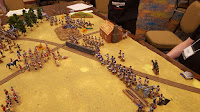In an earlier post I mentioned in passing an "Imaginations" project I called the War of Franconian Succession. Originally inspired by Henry Hyde's War of Faltenian Succession, it began a chain of events that led me to this point. Several years ago, I found my interest revived of using 54 mm figures for war gaming with the discovery, quite by chance, of Ken Cliffe's All the King's Men website. This was around 2013/2014 when the bicentennial of the War of 1812 was being hardly remembered here in the US and probably celebrated by our good friends in Canada. This led to the build up and painting of small (about half a dozen units each) armies to try out this new interest of mine. Later, the whole project was put on indefinite hold as our club started getting very much involved with the Chain of Command WW2 rules--armies needed to be raised!
Well, after purchasing a couple of ATKM's Hessian musketeers and a unit of grenadiers, the seed was planted, only to be diverted into the American War of Independence (AWI), the subject of several posts on this blog. So what about Franconia?
Perusing my copy of John Mollo's Uniforms of the Seven Years War 1756-63 (ISBN 0-88254-444-6), now sadly out of print, I became increasing interested in the smaller states, and their Kreis regiments. Each uniform was unique but broadly defined as being in the Austrian or Prussian style. Further research using the Pengel books gave me more details, but what about standards? Easily taken care of! There is a firm in Barcelona, Spain, called Adolfo Ramos Flags, with whom I have done a great deal of business over the last few years (highly recommended both for their quality and fast service). In their listings of SYW standards, there was Franconia and flags for all three of its Kreis regiments. The uniforms were Prussian in cut, and flags were available. What's not to like? So, the War of Franconian Succession was conceived.
My first units will be Saxon (or in this case, Thuringian), along with some Franconian. I've attached a couple of pictures below showing my initial efforts (using BTW HaT's SYW Prussians). As the project moves along, I'll post more information and reports.
Perhaps next time I'll provide the imagined history of the War that Never Was, except in the wonderful world of imagination.
 |
| Saxon Fusilier Regiment Rochow |
 |
| Saxon Regiment Sachsen-Gotha |
 |
| Saxon Regiment Prinz Maximilian |















